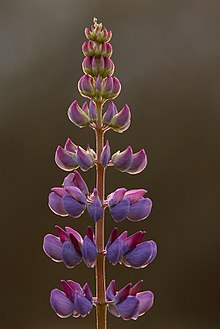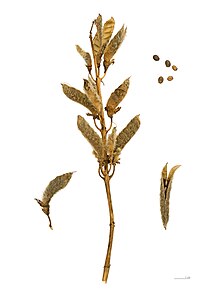Multi-leaved lupine
| Multi-leaved lupine | ||||||||||||
|---|---|---|---|---|---|---|---|---|---|---|---|---|

A colorful mixture of cultivated forms |
||||||||||||
| Systematics | ||||||||||||
|
||||||||||||
| Scientific name | ||||||||||||
| Lupinus polyphyllus | ||||||||||||
| Lindl. |
The many-leaved lupine ( Lupinus polyphyllus ), also known as the herbaceous lupine , is a species of the lupine genus ( Lupinus ), which belongs to the subfamily of the butterflies (Faboideae) within the legume family (Fabaceae).
description
Vegetative characteristics
The many-leaved lupine is an upright, perennial, herbaceous plant that reaches heights of 60 to 150 centimeters. There are rhizomes formed as Überdauerungsorgane. The plants are usually not branched.
The alternate leaves are arranged in a petiole and a leaf blade. The fingered leaf blades consist of 9 to 17 leaflets. The leaflets are lanceolate-pointed with a length of 3 to 15 centimeters. The stipules are fused with the petioles.
Generative characteristics
The bloom, which usually appears from the second year of standing, extends from late May to early August. The terminal, upright, racemose inflorescence is up to 50 centimeters long and contains 50 to 80 flowers.
The hermaphrodite flowers are zygomorphic and five-fold with a double flower envelope . The natural form has blue, rarely white petals . The five petals are in the typical shape of the butterfly flower together with a boat, wing and flag. The flag is a little shorter than the wings. There are two circles with five stamens each. There is only one carpel .
The hairy, flattened, curved legume is 2.5 to 6 inches long and contains four to twelve seeds. With a length of 3 to 5 millimeters, the seeds are grayish with dark spots.
The number of chromosomes is 2n = 48.
ecology
The many-leaved lupine is a perennial hemicryptophyte . Vegetative reproduction occurs through underground runners .
It is a raw soil pioneer and nitrogen collector through relatively large root nodules with symbiotic bacteria of the genus Rhizobium , which can bind a particularly large amount of atmospheric nitrogen . These bacteria, which live freely in the soil but do not bind nitrogen there, penetrate the plant's root bark via the hairs . They are attracted by special signal proteins secreted by the roots. The bacteria react to this by releasing lipo-oligosaccharides, which are known as "nodulation factors". These in turn lead to reactions in the host plant. The root hairs bend in and press the bacteria against the cell wall , which then excretes the pectin- dissolving enzyme polygalacturonase , which is necessary for entry, and also triggers abundant cell division in the cortex cells, which ultimately lead to the formation of galls , the "nodules". Compared to normal cells, the nodule cells reach up to 80 times larger volume. They are necessarily highly polyploid and have up to 64 chromosomes . The nodule bacteria now multiply in them and finally transform into so-called bacterioids . Up to 80,000 bacterioids have been estimated. The host plant delivers up to more than half of the carbohydrates it produces to the bacteria and, conversely, receives organic nitrogen compounds from the bacterioids. In the end, almost all of the microbes are dissolved, and last but not least, the nodules themselves also die. After that, however, enough bacteria still remain in the soil for a renewed infection of the host plants. Overall, both partners benefit greatly from each other thanks to the temporary symbiosis.
From an ecological point of view, the many-leaved lupine is a male "pollen butterfly flower with a pump mechanism". The pumping mechanism is triggered by pressing down the boat when heavy insects sit on it. In the younger flowers the ocher-colored pollen oozes from the tip of the boat, in the older flowers the stylus appears with the scarred head. Since the flower does not offer any nectar , no nectar gap has to remain free, that is, all ten stamens in the lower part have grown together to form a tube. The stamens are in two rows; the longer ones empty into the flower bud, the shorter ones continue to grow and act like pistons, forcing the pollen outwards when the boat is pressed. The pollination is done by bees and related bee species. Self-pollination is prevented by a ring of hair at the base of the scar.
The fruit flaps of the legumes tear open explosively when they dry out, curl up in a spiral due to the tension due to crossed cellulose bands and throw the seeds away with great force over several meters (desiccation spreader). The spherical seeds also spread as trolleys. They are dark germs and cold germs . Thanks to the firm shell and reserves of the cotyledons , they can germinate for over 50 years. Fruit ripening is from July to October.


The multi-leaved lupine has been rated as an invasive species by the Federal Agency for Nature Conservation.
distribution
The original range of Lupinus polyphyllus is the Pacific North America from British Columbia to California . There it grows on oceanic mountain meadows up to altitudes of 2900 meters. The occurrence has been extended to many parts of North America by humans.
The many-leaved lupine was introduced to England in 1826 and has become a widespread garden plant through breeding in the temperate latitudes . Today it is cultivated in numerous color variations. It also tends to run wild - first recorded for Germany in Bavaria in 1890. It is the most common type of lupine in Central Europe . Apart from gardens, this neophytic (= alien) plant prefers to grow on embankments of roads and railways, on the edges of forests and in clearings. This species is one of the 15 most common neophytes in Germany today . In the Allgäu Alps, it rises west of Obermaiselstein between the Upper Mittelbergalpe and Riedbergstrasse in Bavaria to an altitude of 1350 meters.
The plant was included in the black list of invasive neophytes in Switzerland because of its potential for spreading and the damage it causes in the areas of biodiversity , health and economy .
Systematics
Lupinus polyphyllus was first published by John Lindley . Lupinus polyphyllus belongs to the subgenus Platycarpos in the genus Lupinus .
toxicology
Sheeted lupins are toxic by quinolizidine - alkaloids ( lupinine , Hydroxilupinan ), especially the seeds, the seeds of sweet lupines whereas (bred to 1920) only one alkaloid content of 0.02-0.05% contain instead of 5%.
use
Since they are nitrogen collectors due to the " nodule bacteria ", cultivated forms are used as green manure . Many lupins are also sown as ornamental plants and to fortify embankments. A drastic example of a lack of ecological insight is the sowing of lupins on motorway embankments. The lupins, which the game likes to accept as fodder plants, lead to frequent game movements and thus to numerous accidents with game.
Hybrids
There are a number of breeding lines (selection): 'Russels-Hybriden', 'Gallery', 'Minarette'
and single varieties (random selection): 'Chandelier', 'My Castle', 'Edelknabe', 'Schloßfrau', 'Fräulein', 'Schatzalp', 'Kastellan'
swell
literature
- Ruprecht Düll , Herfried Kutzelnigg : Pocket dictionary of plants in Germany and neighboring countries. The most common Central European species in portrait . 7th, corrected and enlarged edition. Quelle & Meyer, Wiebelsheim 2011, ISBN 978-3-494-01424-1 .
Individual evidence
- ^ Lupinus polyphyllus Lindl., Perennial Lupine. In: FloraWeb.de.
- ^ Erich Oberdorfer : Plant-sociological excursion flora for Germany and neighboring areas . With the collaboration of Angelika Schwabe and Theo Müller. 8th, heavily revised and expanded edition. Eugen Ulmer, Stuttgart (Hohenheim) 2001, ISBN 3-8001-3131-5 , pp. 580 .
- ↑ A lot of information about this neophyte. ( Memento of the original from May 25, 2014 in the Internet Archive ) Info: The archive link was inserted automatically and has not yet been checked. Please check the original and archive link according to the instructions and then remove this notice. (German)
- ↑ Erhard Dörr, Wolfgang Lippert : Flora of the Allgäu and its surroundings. Volume 2, IHW-Verlag, Eching near Munich, 2004, ISBN 3-930167-61-1 , p. 114.
- ^ Federal Office for the Environment FOEN: Invasive Alien Species . ( admin.ch [accessed on August 6, 2019]).
- ↑ S. Buholzer, M. Nobis, N. Schoenenberger, S. Rometsch: List of the alien invasive plants of Switzerland . Ed .: Infoflora. ( infoflora.ch [accessed on August 6, 2019]).
Web links
- Lupinus polyphyllus in the Germplasm Resources Information Network (GRIN), USDA , ARS , National Genetic Resources Program. National Germplasm Resources Laboratory, Beltsville, Maryland. Retrieved August 18, 2017.
- Profile and distribution map for Bavaria . In: Botanical Information Hub of Bavaria .
- Lupinus polyphyllus Lindl. In: Info Flora , the national data and information center for Swiss flora . Retrieved November 10, 2015.
- Description for species from British Columbia.
- The lupine as a poisonous plant.





